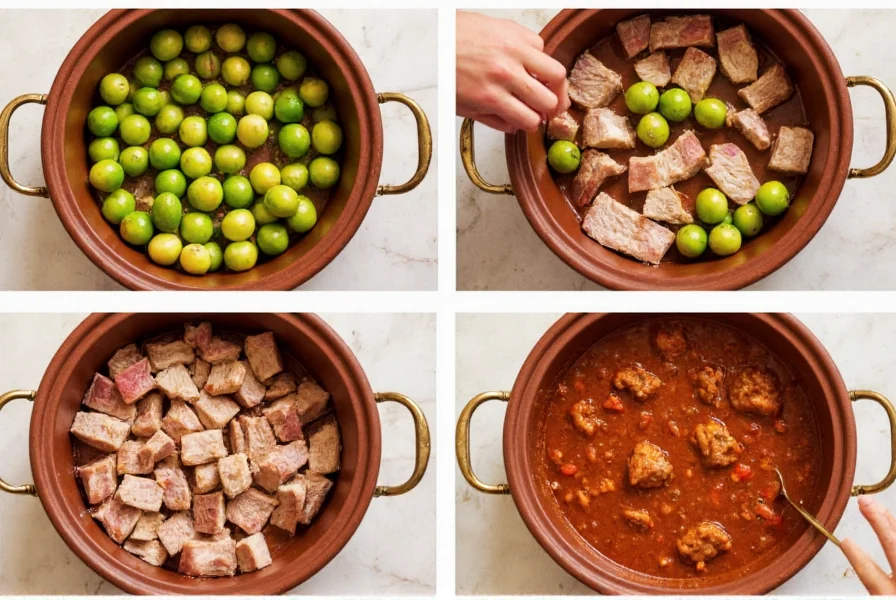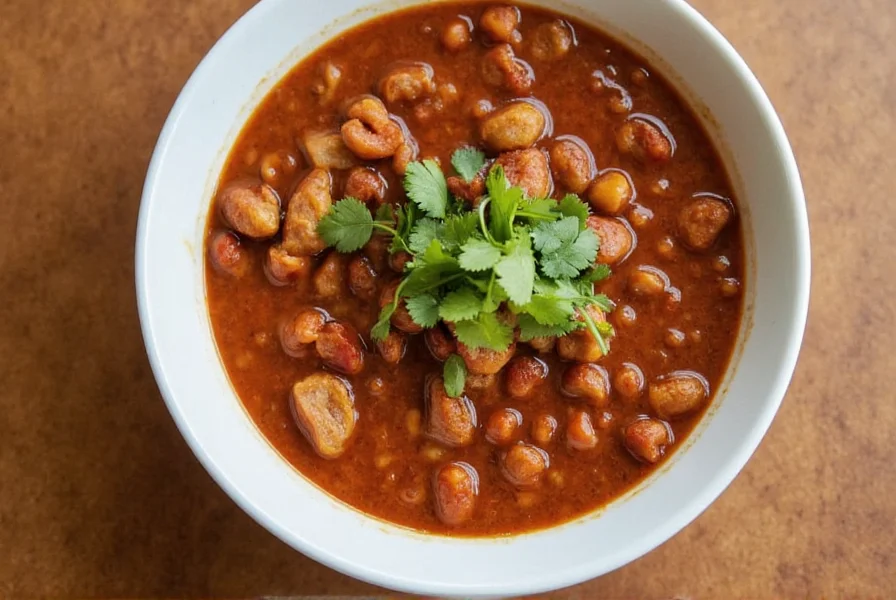What Makes Chili Pork Verde Special
Chili pork verde stands apart from conventional chili recipes through its signature green sauce base. While most chili recipes rely on tomatoes and red chilies, pork verde uses tomatillos—the small, green, husk-covered fruit that forms the backbone of authentic salsa verde. This creates a brighter, more complex flavor profile with natural acidity that cuts through the richness of the pork.
The "verde" in the name directly translates to "green" in Spanish, referring to both the color and primary ingredients of the sauce. Traditional versions often feature pork shoulder, which becomes meltingly tender during the slow cooking process, absorbing the vibrant flavors of the green chili sauce.
Essential Ingredients for Authentic Chili Pork Verde
Creating an authentic chili pork verde requires specific ingredients that contribute to its distinctive flavor profile:
| Ingredient Category | Key Components | Why It Matters |
|---|---|---|
| Green Base | Tomatillos, serrano peppers, jalapeños | Provides the signature tangy flavor and vibrant green color |
| Pork Selection | Pork shoulder (Boston butt), pork loin | Marbled cuts that become tender during slow cooking |
| Aromatics | White onion, garlic, cilantro | Builds flavor foundation and adds freshness |
| Seasonings | Cumin, Mexican oregano, bay leaves | Traditional spices that complement the green sauce |
Step-by-Step Preparation Guide
Follow these steps for perfect chili pork verde every time:
- Prepare the green sauce: Roast 1.5 lbs tomatillos, 2 jalapeños, and 1 white onion until charred. Blend with 3 garlic cloves, 1/4 cup cilantro, 1 tsp cumin, and salt.
- Prepare the pork: Cut 2 lbs pork shoulder into 1.5-inch cubes, removing excess fat. Pat dry and season generously with salt and pepper.
- Sear the pork: In a large pot, brown the pork in batches over medium-high heat. This step develops flavor through the Maillard reaction.
- Simmer: Return all pork to the pot, add the blended green sauce, 1 cup chicken broth, 1 bay leaf, and 1 tsp Mexican oregano. Bring to a simmer.
- Slow cook: Cover and cook on low heat for 2-3 hours until pork is fork-tender. For deeper flavor, cook 4-6 hours on low in a slow cooker.
- Final adjustments: Remove bay leaf, skim excess fat, and adjust seasoning. For thicker sauce, simmer uncovered for 15-20 minutes.

Pro Tips for Perfect Chili Pork Verde
Master this dish with these professional cooking insights:
- Tomatillo selection: Choose firm, bright green tomatillos that fill their husks completely. Avoid any with dark spots or that feel dry inside the husk.
- Heat control: For authentic chili pork verde with balanced heat, remove jalapeño seeds and membranes. Add them back gradually if you prefer spicier results.
- Texture secret: For restaurant-quality texture, remove about 1 cup of cooked pork, shred it, and return it to the pot during the final 30 minutes of cooking.
- Flavor development: Let the finished chili rest overnight. The flavors deepen significantly, making it even better the second day.
Serving Suggestions and Traditional Pairings
Chili pork verde shines when served with complementary sides that enhance its vibrant flavors:
- Classic accompaniments: Warm corn tortillas, Mexican rice, and refried beans create a traditional meal combination
- Cooling elements: Fresh avocado slices, sour cream, or queso fresco balance the dish's heat
- Texture contrast: Crumbled tortilla chips or toasted pumpkin seeds add satisfying crunch
- Fresh finish: A squeeze of lime juice and additional chopped cilantro brighten the flavors just before serving
Variations and Adaptations
Customize your chili pork verde to suit different preferences and cooking methods:
- Slow cooker method: After searing the pork and preparing the sauce, transfer everything to a slow cooker and cook on low for 6-8 hours
- Instant Pot version: Use the sauté function for searing, then pressure cook for 35 minutes with natural release
- Vegetarian adaptation: Substitute jackfruit or mushrooms for pork, using vegetable broth instead of chicken broth
- Smoky variation: Add 1-2 chipotle peppers in adobo sauce for a deeper, smoky dimension to the green chili base

Storage and Reheating Instructions
Chili pork verde stores exceptionally well, with flavors improving over time:
- Refrigeration: Store in an airtight container for up to 5 days. The acid from the tomatillos helps preserve freshness.
- Freezing: Freeze portions for up to 3 months. Thaw overnight in the refrigerator before reheating.
- Reheating: Gently warm on the stove over medium-low heat, adding a splash of broth or water if needed. Avoid boiling to preserve texture.
- Revitalizing: Add fresh cilantro and a squeeze of lime after reheating to restore brightness to the flavors.
Frequently Asked Questions
What cut of pork works best for chili pork verde?
Pork shoulder (also called Boston butt) is ideal for chili pork verde because its marbling and connective tissue break down during slow cooking, resulting in incredibly tender meat. The fat content also helps carry the flavors of the green chili sauce. While pork loin can work in a pinch, it lacks the fat content needed for optimal texture and may become dry during cooking.
Can I make chili pork verde without tomatillos?
While tomatillos are essential for authentic chili pork verde, you can create a substitute if absolutely necessary. Use 1 cup of tomatillo salsa combined with 1/2 cup of green tomatoes or underripe regular tomatoes. However, the distinctive tart flavor of tomatillos is difficult to replicate exactly. For best results, seek out tomatillos at Mexican grocery stores or well-stocked supermarkets—they're typically available year-round.
How can I adjust the spiciness level of chili pork verde?
You can easily control the heat level in chili pork verde by adjusting the peppers. For mild verde, use only 1 jalapeño with all seeds and membranes removed. For medium heat, include 1-2 jalapeños with some seeds. For spicy chili pork verde, add serrano peppers (which are hotter than jalapeños) or include all seeds and membranes. Remember that the heat will mellow slightly during cooking, so it's better to start with less and add more if needed.
What's the difference between chili pork verde and traditional red chili?
The primary difference lies in the base ingredients and resulting flavor profile. Traditional red chili uses tomatoes and dried red chilies, creating a richer, deeper flavor. Chili pork verde uses tomatillos and fresh green chilies, resulting in a brighter, more acidic, and herbaceous profile. The cooking techniques also differ slightly, with verde typically requiring less cooking time for the sauce components to preserve their fresh characteristics.











 浙公网安备
33010002000092号
浙公网安备
33010002000092号 浙B2-20120091-4
浙B2-20120091-4